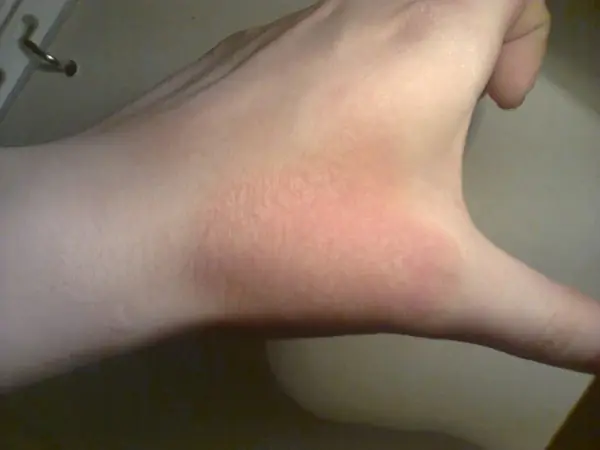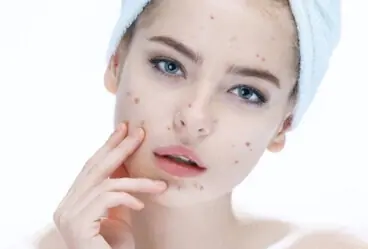
Content:
Small red spots on the skin of the body
There are many different types of acne and different types of rashes, and learning to differentiate between them will give you insight into your treatment options. And proper treatment, especially in the initial stages, is known to be very important.
Naturally, not every rash requires immediate medical attention, but in some cases, delay can be very, very expensive.
Sometimes nasty small spots on the skin of the body are a symptom of a serious illness.
Listed below are some of the most common skin diseases and conditions that cause small red spots on the body.
Eczema

Also known as atopic dermatitis, eczema is a condition characterized by dry, sensitive skin, itching, and dark, scaly, wet or dry patches. Eczema is usually very itchy, itchy and can become inflamed.
It is very important not to confuse eczema with other types of dermatitis - seborrheic, for example, since these are different diseases, although they all have the same essence - inflammation of the skin.
Favorite places for eczema are the inner bends of the elbows and knees.
However, this skin condition is controllable. Stress and allergens can worsen attacks, but daily bathing and regular hydration can reduce it.
Cherry angiomas
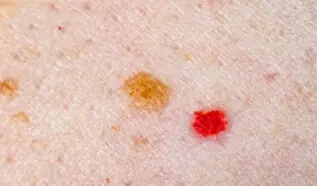
If you notice a tiny mark that looks like a red speck of blood, it's most likely a cherry angioma.
Cherry angioma is a firm red, blue or purple papule with a diameter of 0.1-1 cm. When thrombosed, they may appear black in color until diagnosed with a dermatoscope, when the red or purple color is more easily seen. Cherry angioma can develop on any part of the body, but most often appears on the scalp, face, lips and torso.
This phenomenon is quite common and most often occurs in people over 30 years of age.
Their red color comes from a damaged blood vessel under the skin.
Experts are not entirely sure what causes the anomaly, but genetics is considered the leading theory today. Typically, these small red dots are harmless, but contact your doctor if you see them growing or changing shape or color.
Follicular keratosis
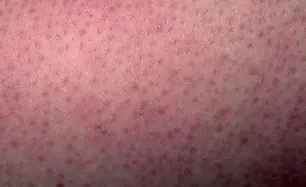
Keratosis pilaris appears as small red bumps. The condition is thought to be caused by a genetic disorder, and the severity of symptoms can fluctuate depending on the season. Typically, the worsening will go away or improve in the summer, but worsen during the winter months.
The bumps are red in color and are located mainly near the hair follicles. They do not cause any particular health concern, but are a serious cosmetic problem.
A specific trigger for the onset of the disease is a deficiency of vitamins A, C, K or any allergic reactions.
Regular moisturizing may relieve symptoms slightly, but there is no known cure.
Petahia
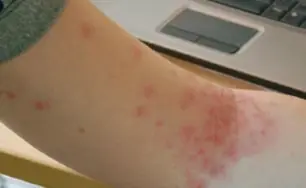
Petachias are a rash caused by bleeding and most often occur in clusters. They can appear on the eyelids or even inside the mouth.
When this rash occurs, it is important to keep an eye on it because it can be a sign of various problems.
Typically, clusters appear in response to an allergic reaction. They can also occur in cases of injury, autoimmune diseases, or viral infections that affect the blood's ability to clot.
Patients undergoing chemotherapy or radiation therapy may also develop petachia as a reaction to medications.
Usually, if such a rash is caused by an infection, the doctor can prescribe antibiotics that will clear them up quickly; in other cases, treatment is tailored based on the cause of the problem.
Hives
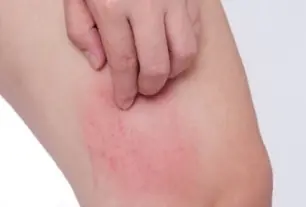
Hives are the result of an allergic reaction in response to food, pollen and even medications and are characterized by a rash that looks like raised, terribly itchy welts that sometimes burn.
Hives occur anywhere on the body; it may appear as small spots or become large throughout the body. Usually disappears completely within a few days. If you experience this phenomenon frequently, be sure to do a skin allergy test to find out what you should avoid.
Shingles

Shingles is caused by the varicella zoster virus. It appears in the form of dots that can tingle.
But the first warning sign is pain, which can begin to develop five days before the rash appears. The pain can be mild for some and very intense for others.
"You typically feel an acute onset of pain that is localized to one area," says David Pietrak, professor of medicine and chief of the division of infectious diseases at the University of Chicago Medicine in Illinois.
And a rash will soon appear there. These cup-shaped blisters are most often located on the torso. The second most common locations are the face, neck and back.
But in some cases, instead of pain, the rash is preceded by itching.
These spots then begin to blister and become painful. It takes weeks, and in some cases months, for the rash to completely disappear.
Capillarite
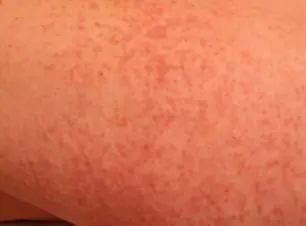
Capillaritis is fairly harmless and is characterized by red or brown spots that are caused by capillaries leaking under the skin. Typically, this is blood from superficial blood vessels. Those with capillaritis often experience petahia spots.
In most cases, this condition does not require treatment and goes away on its own within a few weeks.
It most often occurs in people whose work involves spending long periods of time on their feet.
Also known as Schamberg's disease.
Small red spots on the skin of the legs
Small red spots on the skin of the legs can be either ordinary insect bites, harmless in most cases, which will go away very soon without treatment, or a symptom of various diseases, including internal organs.
Leukocytoclastic vasculitis
A common symptom of leukocytoclastic vasculitis is a rash on the skin, including the legs, due to inflammation in the blood vessels, which leads to their damage and subsequent leakage. Thus, the blood vessels cause hemorrhage in the form of violet-red spots called palpable purpura. 
These raised lesions occur in multiple areas on the legs or other parts of the body, and these discrete, grouped lesions are usually painful and itchy.
Typically these spots remain on the skin for 1-4 weeks. They are sometimes accompanied by painful, large and ulcerated blisters, indicating the severity of the blood vessel inflammation. Sometimes the rash is accompanied by:
- muscle pain,
- fever,
- stomach pain
- cough,
- vomiting,
- weakness.
If all of these signs and symptoms are persistent, this indicates that it is time to visit a doctor.
Insect bites
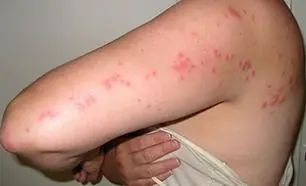
You have been walking outside barefoot or wearing open-toed sandals and may have been bitten by insects such as ants or mosquitoes.
Bites from any of these insects can cause one to several red spots on the skin.
If you have been outside or near an animal that has fleas, you may also have been bitten by them. Corticosteroid creams or lotions will help relieve the itching because in most cases you will not need any other treatment.
Psoriasis
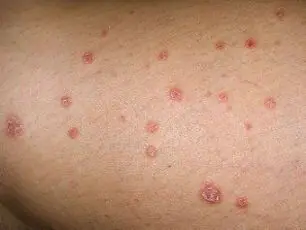
If you have a history of psoriasis, red spots on your legs may be a flare-up. And even if you've never had psoriasis, these spots may be the first sign of it. Triggers for psoriasis may include:
- dry air,
- infection,
- stress,
- excessive sunlight or lack thereof,
- weak immune system.
Psoriasis on the legs, especially in the initial stages, usually appears as pink red patches on the lower part of the legs. The skin may be itchy, raised and thick.
Hand, foot and mouth disease
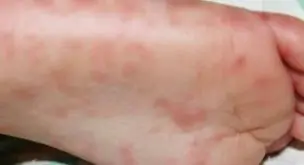
If red spots appear in a child under 5 years of age, it may be hand, foot, and mouth disease, a viral infection that spreads from person to person. Along with red spots, other symptoms may include:
- fever,
- lack of appetite,
- a sore throat,
- general weakness.
Red spots usually appear on the soles of the feet. There is no specific treatment for this disease; as a rule, it goes away on its own. But fever and pain are relieved with painkillers and anti-inflammatory drugs.
Blister
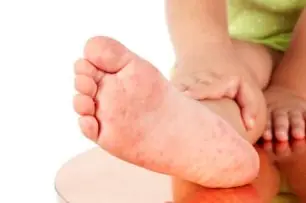
If the red spot is filled with clear fluid or blood, it is a blister. Blisters are usually the result of constant friction or stress on the skin and feet and can be caused by:
- sunburn,
- sweating,
- tight shoes,
- allergic reactions.
Blisters usually heal on their own, but should not be popped. The skin helps prevent infection from entering the wound.
Allergic reaction
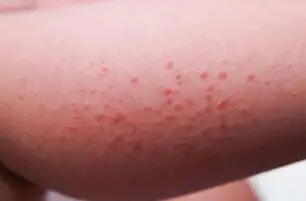
If you are allergic to a grass, plant, or other allergen, you may develop a red, itchy, and slightly swollen rash when you come into contact with it.
If you have a rash on your legs, it's important to find out how your allergic reaction works.
Your doctor may prescribe allergy medicine.
Cortisone cream or OTC antihistamine may help relieve symptoms.
Other ointments include:
- Fexofenadine (Allegra)
- Loratadine (Claritin)
- Diphenylhydramine (Benadryl)
- Brompheniramine (dimethane)
- Chlorpheniramine (chlor-trimeton)
- Clemastine (Tavist)
- Cetirizine (Zyrtec).
Melanoma
Squamous cell carcinoma or squamous cell carcinoma is the most common form of skin cancer of the legs.
Most types of early squamous cell carcinoma are limited to the skin and do not metastasize. However, in later stages, some may become more aggressive and spread throughout the body.
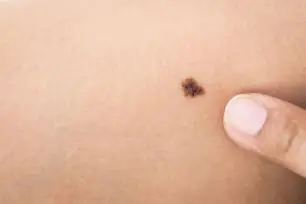
This form of cancer often begins as a small, scaly inflammation. Sometimes recurrent cracking or bleeding occurs, less often as a severe projective callus-like lesion.
Although squamous cell carcinoma is painless, it can be itchy and resemble a plantar wart, fungal infection, eczema, ulcer, or other common foot skin conditions.
Malignant melanoma: is one of the deadliest skin cancers. Nonsurgical treatments are rarely effective, and many remain experimental. This type of skin cancer must be detected very early to ensure the patient's survival.
Melanomas can occur on the skin of the feet, and sometimes under the nail, and are found on both the soles and the top of the feet.
As melanoma grows and penetrates deeper into the skin, it becomes more severe and can spread throughout the body through lymphatics and blood vessels.
Malignant melanoma has many potential manifestations, leading to its nickname "The Great Masquerader". This skin cancer usually begins as a small brown-black spot or bruise; however, about a third of cases lack brown pigment and are therefore pink or red in color.
These tumors resemble ordinary moles; however, careful examination usually demonstrates asymmetry, irregular borders, discoloration, and/or a diameter greater than 6 mm. Melanomas may resemble benign moles, blood blisters, ingrown toenails, plantar warts, ulcers caused by poor circulation, foreign bodies, or bruises.
When red rashes appear on the skin, it is necessary to take measures for treatment, since the causes of their appearance can indicate both stress and a serious illness. The sooner measures are taken to treat them, the more successfully you can get rid of them. Next, you will learn what types of red rashes on the skin there are, their signs and treatment.
Types of red spots on the body
Redness on the body is usually divided into several types, depending on the reason that caused it. For example, red spots may appear due to sun abuse or due to an infectious disease.
Let's look at the most common reasons why red rashes occur and their characteristic signs.
Dermatitis is a rash in the form of blisters, peeling, discomfort, itching, burning, etc. The reasons may be different, depending on which there are several types of dermatitis, for example, infectious, allergic, atopic, food, etc.
The cream contains exclusively natural ingredients, including beekeeping products and plant extracts. High efficiency, virtually no contraindications and minimal risks of side effects. Amazing results of treatment with this drug are evident in the first weeks of use. I recommend.
Causes of red spots on the body
The causes of redness are often associated with processes that occur in the body. In this case, changes occurring on the skin are harbingers of disorders in the body. They can be either completely harmless or symptoms of a serious illness; we will talk about common causes of the appearance of red spots below.
Allergic reactions
An allergic reaction is usually understood as the body’s sensitivity to certain substances, foods, pollen, animal dander, etc. Often characterized by watery eyes, sneezing and runny nose, the body is often covered in spots. It should be noted that Allergy symptoms may vary depending on the individual characteristics of the body.
Hives
The term urticaria means allergic-toxic disease, which can appear both upon contact with allergens and upon ingestion. Toxic substances can also be produced by the body itself.
With urticaria, disturbing red spots appear, itchy and slightly protruding above the surface of the skin. It can be caused by both food and external irritants. It may be accompanied by fever, increased body temperature, chills, and possibly nausea.
If you look at a photo of urticaria, you can see that people with this disease develop red raised spots and blisters may appear.
Allergic dermatitis
Allergic dermatitis is a skin disease that is caused by contact with substances that cause an allergic reaction.
This disease manifests itself due to contact with a certain component. The first signs of allergic dermatitis are detected a short time after interaction with the allergen.
If you look at photos of people with allergic dermatitis, then you can see that with this disease red spots appear, in place of which weeping wounds form. Rashes can form on any part of the body and mucous membranes.
Here you can see more photos of allergies in children.
Tired of fighting dermatitis?
Peeling of the skin, discomfort and itching, redness, rashes in the form of blisters, cracks, weeping wounds, hyperemia, burning are signs of dermatitis.
Treatment requires an integrated approach and this cream, which has a 100% natural composition, will be a good helper.
In such cases, our readers recommend using this product - ZDOROV cream-wax with bee venom.
It has the following properties:
- Relieves itching after the first use
- Eliminates rashes and peeling skin in 3-5 days
- Reduces excessive skin cell activity
- After 19-21 days, completely eliminates plaques and traces of them
- Prevents the appearance of new plaques and an increase in their area
Infectious diseases
One of the symptoms of infectious diseases may be the appearance of a red rash and spots. They are often accompanied by weakness, deterioration in general health and an increase in body temperature. In case of infectious diseases, you should seek medical help and isolate the patient from others until complete recovery.
Measles is a viral disease that often occurs in childhood. Typically, infection occurs by contact and airborne droplets and is easily transmitted. Therefore, with this disease, the patient should be isolated from healthy people.
The onset of the disease is usually characterized by cough and increased body temperature. Usually the spots start on the face and then spread over the entire surface of the body. In this case, the rashes have a lumpy shape, can merge with each other, and over time begin to dry out and peel off.
The danger of measles is that it can cause complications such as pneumonia, stomatitis and hepatitis.
In the photo you can see that rash on body due to measles has its own characteristic features. After three to four days, the spots lighten, but leave behind pigments (brown spots on the skin).
Stories from our readers!
“I suffered from dermatitis. My hands and face were covered with small spots and cracks. No matter what I tried, the drugs only helped for a while. A colleague advised me to order this cream.
Finally, thanks to the cream, I completely got rid of the problem. After the third procedure, the burning and itching disappeared, and after 4 weeks the signs of dermatitis disappeared. I am very pleased and recommend using this cream to all people suffering from skin problems."
Rubella
It is an acute infectious disease caused by a virus. Children without rubella vaccination and women are prone to the disease.
With rubella, the virus enters the body and can remain there from 10 to 25 days in a latent state, then spreads throughout the body. A runny nose and sore throat may occur. The disease is more severe in adults - body temperature rises to 39 degrees, muscles and head may ache. Rubella poses a great danger to pregnant women, causing severe fetal defects.
The spots in the photo of rubella are shaped like a circle or oval, appear on the face and go down the body. The rashes are small and may appear on the oral mucosa.
Streptoderma
Streptoderma – an infectious skin disease caused by streptococci. Often occurs with a natural decrease in the local immunity of the skin.
When the protective functions of the skin decrease, streptococci penetrate inside, causing its damage. Areas of impact are often the face, arms and legs. Exposed areas of the body are especially susceptible to this disease.
If you look at the photos of patients with streptoderma, most of them develop impetigo – damage to the upper layers of the skin. In this case, first there is a reddening of the body area, then a bubble with a yellowish content appears, which bursts after a while and dries out, forming a yellowish crust.
Here you can see photos of streptoderma in children.
Scarlet fever
It is a disease in which rashes and peeling of the skin occur. It is often accompanied by a sore throat and fever.
With this disease, inflammation occurs in the nasopharynx, where toxins are produced that cause poisoning of the body, under the influence of which rashes are formed. Toxic substances affect the surface layers of the skin, as a result of which it begins to peel off severely. Features of scarlet fever are the risk of serious complications.
In the photo you can see that with scarlet fever Very small rashes form, especially on the elbows and knees - thickening and darkening of the rashes is observed. The palatine tonsils are coated with plaque, the tongue is inflamed, and the papillae are enlarged. After a few days, peeling of the skin may appear, for example on the palms.
Autoimmune processes
Autoimmune diseases are called processes in which the activity of the immune system is impaired. In this case, the body begins to reject its own tissues, perceiving them as foreign. This group of diseases can be called systemic, since organs and the body as a whole can be affected.
Lupus erythematosus
Systemic lupus erythematosus is a disease in which the body destroys its own cells and destroys them. With lupus erythematosus, substances begin to be produced that damage the internal organs and systems of a person. Most of the patients are women.
At the moment, the causes of the disease are unknown; it can probably be inherited and be caused by a defect in the body's immune system.
When lupus erythematosus begins, red, butterfly-shaped rashes appear on the face. It may be accompanied by a spontaneous increase in body temperature, joint pain appears, fatigue, weakness and frequent awakenings at night increase.
lupus erythematosus develops slowly - weakness and joint diseases may begin. In the photo you can see that the disease manifests itself in the form of “butterfly”-shaped rashes on the wings of the nose, as well as redness in the décolleté area.
Dermatological diseases
The most common causes include skin conditions such as eczema and psoriasis. Let's consider them further.
Eczema
Eczema is a skin disease in which itchy blisters and scales appear. With eczema, small blisters may form on the surface of the body, which may itch, and red spots appear nearby.
This disease can be caused by contact with allergens, internal diseases, stress and other factors.
Eczema is not a contagious disease, in which rashes of various shapes form on the skin, which can cause a burning sensation and itching. Before treatment for this disease, an examination is carried out, on the basis of which hormonal ointments and sedatives can be prescribed.
Example of rashes for eczema on the picture.
Psoriasis
Psoriasis is a chronic skin disease that is not infectious. It is characterized by the formation of bright pink spots that itch and peel. With psoriasis, bright spots appear on the body that flake. This disease is not contagious. It lasts a long time and occurs at all ages.
Often the disease appears with a decrease in immunity, which can be caused by skin injuries, diseases of the endocrine system and other factors.
A feature of psoriasis is its wave-like course, in which its symptoms can either worsen or fade. Over time, the intensity of exacerbations and the area affected increases, the disease invades new areas of the body. Psoriasis can also affect the nail plates.
If you look at the photos of patients psoriasis, then the disease begins with small spots and then spreads throughout the body. Rashes with a scaly surface form on the surface of the skin; they become enlarged and itchy.
Other diseases
Reddish rashes may also appear due to other diseases that are not bacterial or viral in nature. These may include vegetative-vascular dystonia and neuroses.
Vegetative-vascular dystonia
This syndrome is otherwise called autonomic dysfunction, includes various dysfunctions of internal organs and functions that are caused by a disorder of their nervous regulation.
With vegetative-vascular dystonia, red rashes may occur during stress, nervous tension, or severe anxiety. Spots often appear on the hands, face and neck area. The spots are caused by a rush of blood to these areas of the body and are caused by a violation of thermoregulation or uneven passage of nerve impulses.
You can see in the photo red spots with vegetative-vascular dystonia, they do not cause physical discomfort and go away on their own after the condition normalizes.
Neuroses
Pink spots can also appear with neurosis, often appearing on the face, neck and décolleté.
With neurosis, the appearance of red spots is accompanied by a feeling of either cold or heat, and possible pain in the limbs and internal organs (heart, stomach). Pain and discomfort may increase under the influence of stress, shortness of breath may appear and the heart rate may increase.
With neuroses, redness of the skin appears, especially during anxiety, panic or phobias.
In the photo you can see that redness occurs with excitement, anxiety and go away quite quickly without symptomatic treatment. They do not cause physical discomfort, do not itch and do not leave marks behind.
Treatment
It should be noted that if red spots of unknown origin appear You should contact a specialist and undergo the necessary examinations, additional consultation with related specialists may be required.
It is worth noting that the appearance of red spots in childhood, especially with an increase in temperature, is a reason to seek emergency medical help without fail.
Conclusion
Thus, red spots do not appear on the surface of the body for no reason - they can be the result of stress, an infectious disease, fungal infection and other diseases.
Every person has encountered such a problem as spotty skin. Due to various factors, the skin of the human body tends to change. Some are more susceptible to this influence, and some less, but the fact remains a fact. Spots on the skin can be either short-term or long-lasting. In the first case, they do not pose a serious threat to human health.
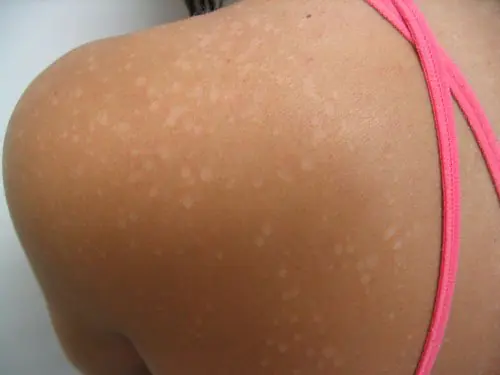
The second signals the rapid development of diseases caused by:
- fungal;
- viral;
- bacterial infections;
- allergic reactions of the body;
- or are signs of weak immunity.
Therefore, it is very important to be able to recognize spots, because they are different, and to know how to deal with them in order to prevent depression of your health.
Types of skin spots
Spots are areas of skin that differ from the main skin in color and structure.
They can be:
- smooth;
- rough;
- protrude above the skin.
In practice, dermatologists divide all neoplasms that are localized on the skin into three main categories:
- pigmented (age-related) – the main reason for their appearance is an imbalance of melanin in the body;
- vascular ("star") - provoke their occurrence of diseases of the cardiovascular system;
- artificial - appear on the body due to the influence of various coloring pigments on the skin - tattoos, makeup.
They are also classified according to the signs of skin diseases - lichen, dermatoses, diathesis, prickly heat, allergies.
Pigment
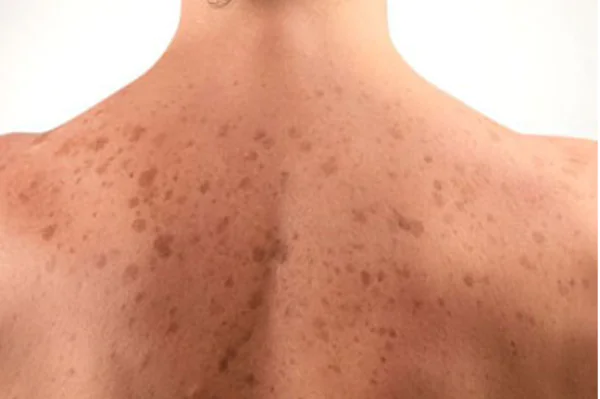
Pigmentation can be either white or brown. In addition, doctors distinguish:
- natural pigmentation, which occurs due to the influence of ultraviolet radiation on the skin - tanning, thus melanin protects the skin from burns, cancer, dermatoses;
- melanin pigmentation associated with excess and deficiency of the main pigment.
An imbalance in melanin production makes itself felt when:
- hormonal disorders;
- during pregnancy;
- taking hormonal medications;
- the onset of menopause in both women and men;
- skin aging;
- genetic inclinations;
- infectious infection.
With a lack of melanin, hypopigmented signs appear on the skin:
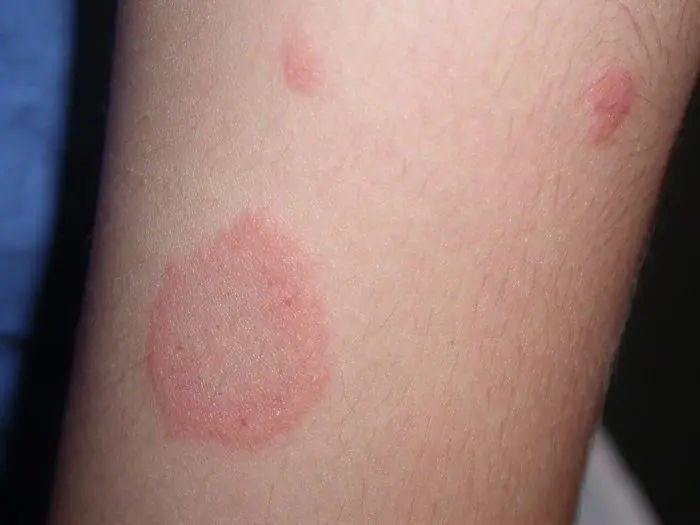
With an excess of melanin, the appearance of hyperpigmented spots is characteristic:
- congenital – moles (nevi), lentigo, birthmarks;
- acquired - age spots (senile lentigo), freckles (ephelides), chloasma.
Most often, pigmentation is localized on the face, décolleté, and hands.
Vascular
Vascular spots have a pink, purple, purplish-red hue. They are classified into the following types:
- hyperemic:
- hemorrhagic;
- telangiectatic.
Hyperemic, in turn, is divided into:
- inflammatory spots filled with blood, resulting from inflammation of the walls of blood vessels, called roseola (diameter less than or equal to 2 cm) and erythema (diameter greater than 2 cm);
- spots of non-inflammatory etiology, manifested as a result of nervous shocks, worries, experiences, called marks of shame.
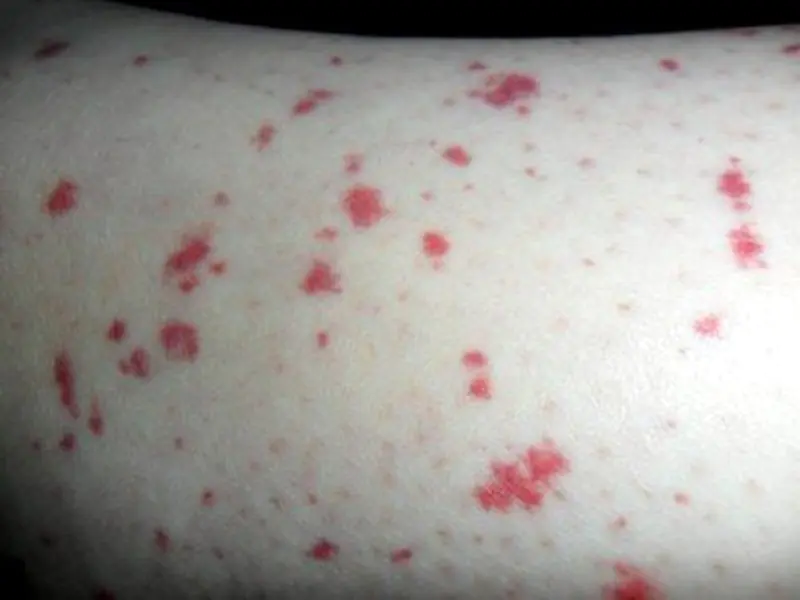
Hemorrhagic formations occur due to:
- external influence - bruises that disappear within a few days;
- manifestations of signs of vascular diseases - traces of internal hemorrhages that require serious medical therapy.
Telangiectatic spots are a consequence of dilation of the walls of blood vessels, a violation of their elasticity due to the influence of diets, smoking and alcohol, diseases of the gastrointestinal tract and heart, and excessive exposure to ultraviolet radiation. They represent the so-called “vascular network”.
Lichen
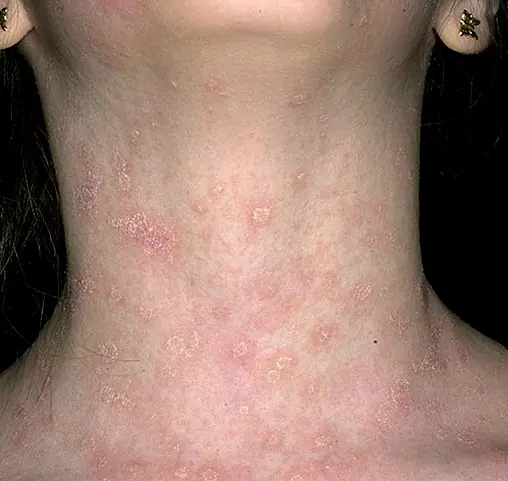
Symptoms of many infectious diseases are reduced to the appearance of spots on the skin. Ringworm is very common. It has both fungal, bacterial and viral etiology, and can manifest itself due to weakened immunity and hereditary predispositions.
Experts determine the type of lichen by the characteristic signs of spots on the skin.
- With pityriasis versicolor, yellow and brown marks with a crust appear on the body.
- With pityriasis rosea - round pink with a red border, flaky.
- With shingles, red inflammation resembles an allergic rash with blisters, which is localized along the nerve trunks on the back, under the ribs.
- With lichen planus, the neoplasms look like nodules that connect with each other, forming large-scale foci of inflammation.
- With lichen alba, white spots appear without clear boundaries.
- Ringworm is characterized by the formation of shapeless bald patches on the head.
The symptoms of lichen are very similar to the rash associated with chickenpox, measles, and rubella. Sometimes lichen is confused with eczema and allergic skin dermatitis.
What can the color of the spots tell?

Multi-colored spots on the skin indicate the health of the body. The external manifestation of signs in the form of spots makes it possible to diagnose many diseases in time, preventing them from developing into a chronic form.
Dark spots
Dark brown manifestations on the skin that do not have clear outlines, called pigmentation, may indicate a disease of the endocrine system, liver, kidneys, or tuberculosis.
Light spots
Neoplasms of light shades draw attention to the fact that the skin is infected with some kind of infection or autoimmune transformations are occurring in the body.
Yellow spots
Yellowness of the skin indicates that the body has increased secretion of bilirubin, which causes jaundice and other liver diseases.
Red spots
Redness of the skin may indicate the development of infectious diseases, vitamin deficiency, decreased immune defense of the body, dermatitis, and allergic predisposition.
Brown spots
Darkening of skin areas may indicate the development of a complex form of dermatitis - photodermatosis, as well as age-related pigmentation.
Treatment
Therapy aimed at treating blotchy skin promotes:
- eliminating hormonal imbalance;
- normalization of the functioning of internal organs;
- strengthening blood vessels;
- identification of allergens that undermine health;
- modeling of stable immunity.
In each specific case, an examination by a specialist is required. Dermatologists, endocrinologists, trichologists, mycologists, neurologists, allergists, and venereologists treat skin diseases. Often, when spots appear on the skin, complex therapy is prescribed.
The origin of the spots is different. To confirm the diagnosis based on external signs of manifestations - size, structure, shape of neoplasms, an in-depth study of skin changes is required. Scraping in places where spots form is a mandatory procedure after examining a sick person by a doctor.
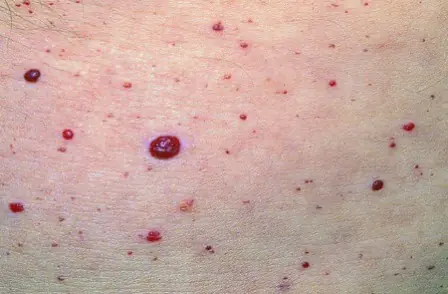
Treatment includes:
- taking oral medications;
- antihistamines;
- hormonal drugs;
- sedatives;
- immunostimulants;
- anti-inflammatory, antifungal ointments.
Self-treatment of stains is unacceptable. If they spread throughout the body, itching, burning and pain, you should not postpone a visit to the doctor.
In the absence of proper treatment for infections that affect the surface layer of the skin, toxins accumulate in the body, damage internal organs, and tissue necrosis.
Preventing skin blemishes

Skin is an indicator of people's health.
Small inflammatory foci in the form of spots tend to develop into large ulcers and wounds, so caring for it should be as follows:
- compliance with hygiene standards;
- the use of non-aggressive cosmetics and detergents;
- avoiding contact with external irritants - using gloves, masks, respirators in everyday life;
- maintaining a healthy lifestyle - giving up bad habits, normalizing sleep and activity patterns;
- compliance with the diet;
- taking fortified courses;
- frequent walks in the fresh air;
- minimizing the effect of ultraviolet radiation on the skin;
- normalization of mental state;
- preference for relaxation activities;
- choosing wardrobe items made from natural fabrics.
The implementation of the above preventive measures is mandatory for frequent relapses of the spotty problem. Following a healthy lifestyle is much easier than finding the root cause of skin diseases and eliminating them.



